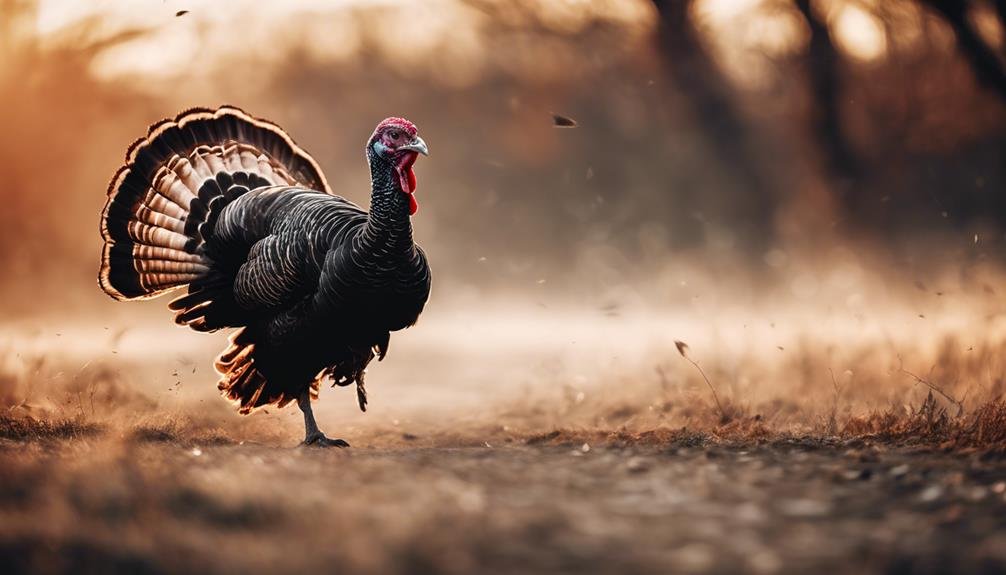When turkey hunting in windy conditions, understanding the bird's instinct to seek refuge in semi-protected areas is essential for success, as they abandon open fields and dense cover to converge on calm spots that provide a temporary reprieve from the storm. Identifying these hidden havens is imperative, as turkeys gather in areas with reduced wind turbulence, making them hotspots for hunters. By adapting to windy conditions, hunters can outmaneuver their quarry, capitalizing on their weaknesses and positioning themselves for triumph. The secrets to mastering windy weather hunts lie in understanding turkey behavior and exploiting their responses to high winds.
Key Takeaways
- Turkeys seek refuge in semi-protected areas, such as low-lying fields, during windy conditions to escape wind turbulence.
- Identifying calm spots, like field edges and valley refuges, increases the chances of finding turkeys seeking shelter from the storm.
- Windproof gear, including clothing and anchor systems, is essential for hunters to stay dry and warm in high-wind conditions.
- Hunters should adapt their strategies to locate calm areas where turkeys congregate, using loud calls to outsmart their quarry.
- Understanding turkey behavior in high winds is key to exploiting their weaknesses and capitalizing on their instinct to seek shelter from the storm.
Understanding Windy Turkey Behavior
As the winds howl and whip across the landscape, turkeys abandon their usual haunts, seeking sheltered havens where they can weather the tempest, and understanding this behavior is key to outsmarting them. Turkeys detest being in wide-open areas where wind turbulence reigns supreme, and they're equally averse to dense cover, likely due to the difficulty of detecting predators. Instead, they opt for semi-protected areas where they can feed and loaf while maintaining a watchful eye. In windy conditions, turkeys may favor low-lying areas in fields, where wind turbulence is reduced. By grasping the intricacies of turkey psyches in high winds, hunters can exploit their weaknesses and gain a crucial edge in the hunt.
Locating Calm Spots in Storms
In the midst of turbulent skies, turkeys seek refuge in pockets of calm, and identifying these hidden havens is vital for hunters seeking to intercept their quarry. Field edges, where forests meet open fields, can provide a buffer from gusty winds, making them ideal locations to spot turkeys. Valley refuges, with their natural windbreaks, also offer a tranquil atmosphere, attracting birds seeking respite from the storm. Even a slight reduction in wind velocity can concentrate turkeys in these areas, making them hotspots for hunters. By pinpointing these calm spots, hunters can increase their chances of success, as turkeys congregate in these areas to feed, loaf, and escape the fury of the storm.
Windy Gear Essentials
When the winds howl and the rain lashes down, the right gear can be the difference between a successful hunt and a miserable, wind-battered defeat. In high-wind conditions, investing in windproof fabric for your clothing and gear can be a game-changer. This fabric technology helps you stay dry and warm, even in the most torrential rain and gale-force winds. Essential for securing your blind and decoys in place, preventing them from being blown away or destroyed, are anchor systems that can withstand high winds, such as screw-in stakes and weighted anchors. In addition, with the right gear, you'll be well-equipped to tackle even the most challenging windy conditions and bring home the bacon – or in this case, the turkey.
High-Wind Turkey Hunting Strategies
Turkeys respond to windy conditions by altering their behavior, and savvy hunters can capitalize on these adaptations by employing strategic tactics that play to the birds' vulnerabilities. When Wind Alerts forecast Storm Patterns, hunters should adapt their strategies to locate calm areas where turkeys seek refuge. Identifying these areas is vital, as turkeys congregate in low-lying fields or semi-protected spots to escape strong winds. By understanding turkey behavior, hunters can position themselves in areas with reduced wind, increasing their chances of success. By staying informed about Wind Alerts and Storm Patterns, hunters can plan their hunts accordingly, using loud calls and sturdy gear to outsmart their quarry in high-wind conditions.
Adapting to Windy Conditions
Amidst the howling gusts, savvy hunters must recalibrate their tactics to outmaneuver their wary quarry, adapting their strategies to the whims of the wind. Wind factors play a vital role in stormy situations, as turkeys seek refuge in semi-protected areas where they can feed and loaf while detecting danger. Understanding turkey behavior in high winds is key to exploiting their weaknesses. Identifying calm areas, such as low-lying areas in fields, is essential for finding birds during windy conditions. By adapting to windy conditions, hunters can position themselves for success, capitalizing on the turkey's instinct to seek shelter from the storm. By recognizing the impact of wind on turkey behavior, hunters can refine their strategies to outsmart their quarry, even in the most turbulent of weather conditions.
Wind-Tested Gear and Prep
As the winds howl and whip across the landscape, hunters must arm themselves with gear that can withstand the fury of the gusts, guaranteeing that their equipment remains steadfast and reliable in the face of turbulent weather.
| Gear | Wind-Resistance | Advantages |
|---|---|---|
| Windproof Fabric Blinds | High | Reduces wind noise, maintains visibility |
| Storm Anchors | High | Secures decoys, prevents loss |
| Sturdy Stakes | Medium | Keeps gear grounded, reduces damage |
When it comes to wind-tested gear, hunters should prioritize windproof fabric, storm anchors, and sturdy stakes. These essentials will guarantee that your gear remains reliable, even in the most turbulent conditions. By investing in high-quality equipment, you'll be better equipped to tackle the challenges of windy weather and increase your chances of success.
Overcoming Windy Obstacles
When the wind-whipped landscape transforms into a maelstrom of swirling leaves and debris, hunters must be prepared to adapt their strategies and overcome the obstacles that high winds present, lest they find themselves lost in the tempest. As storm chasers of the turkey hunting world, we must be attuned to the Weather Forecast, anticipating gusty conditions that can make or break a hunt. By understanding turkey behavior in high winds, we can pinpoint areas where birds will congregate, seeking refuge from the gale. This is crucial to identify these calm oases, where turkeys will gather to feed and loaf, and to adapt our gear and strategies accordingly. By doing so, we can turn the fury of the wind to our advantage, outsmarting our quarry and emerging victorious in the face of adversity.
Mastering Windy Weather Hunts
Harnessing the power of wind-savvy tactics, turkey hunters can transform the turbulent landscape into a hunting haven, where the elements of chaos are harnessed to corner their quarry. A thorough understanding of turkey behavior in windy conditions is essential for planning a successful hunt. Before heading out, study the weather forecast to anticipate the wind's impact on turkey movement and behavior. This knowledge will inform hunt planning, allowing you to pinpoint areas where turkeys are likely to congregate. By identifying calm areas, such as low-lying fields, and adapting gear and strategies to suit the windy conditions, hunters can turn the wind to their advantage. Effective hunt planning, combined with wind-savvy tactics, is key to mastering windy weather hunts and bagging that elusive gobbler.
Frequently Asked Questions
How Do I Stay Quiet While Setting up Gear in Windy Conditions?
To maintain stealth while setting up gear in windy conditions, prioritize gear organization, ensuring all necessary items are easily accessible, and employ a silent approach, moving deliberately and efficiently to minimize noise and disturbance.
Can Turkeys See Decoys Clearly in Strong Winds?
In strong winds, turkeys' visual acuity is compromised, making it challenging for them to discern decoy details. However, strategically designed decoys with high-contrast colors and realistic features can still deceive turkeys, even in gusty conditions.
Do Turkeys Change Their Roosting Habits During Windy Weather?
During windy weather, turkeys adapt their roosting habits, seeking sheltered roost trees with reduced wind exposure, altering their typical flock behavior to prioritize protection, and opting for more secluded, leeward locations to ride out the storm.
What's the Best Way to Keep Decoys From Blowing Away?
To secure decoys in high winds, employ Decoy Anchors or Weighted Bases that screw into the ground, ensuring a sturdy hold, while also using stakes and tie-downs to prevent spinning or blowing away.
How Do I Maintain a Steady Calling Rhythm in High Winds?
"Amidst the howling gusts, a steady calling rhythm is key. Employ a Windy Whistle, mastered through Cadence Control, to maintain a consistent, rhythmic call that pierces the wind, beckoning in wary turkeys."
Conclusion
In summary, windy weather need not hinder turkey hunting success. In fact, adapting to gusty conditions can prove advantageous. For instance, a study in Wisconsin's Driftless Region demonstrated that turkeys sought shelter in wooded ravines during strong winds, increasing their vulnerability to hunters. By understanding and capitalizing on such behavioral adaptations, hunters can turn windy weather into a strategic advantage, ultimately leading to a successful harvest.









